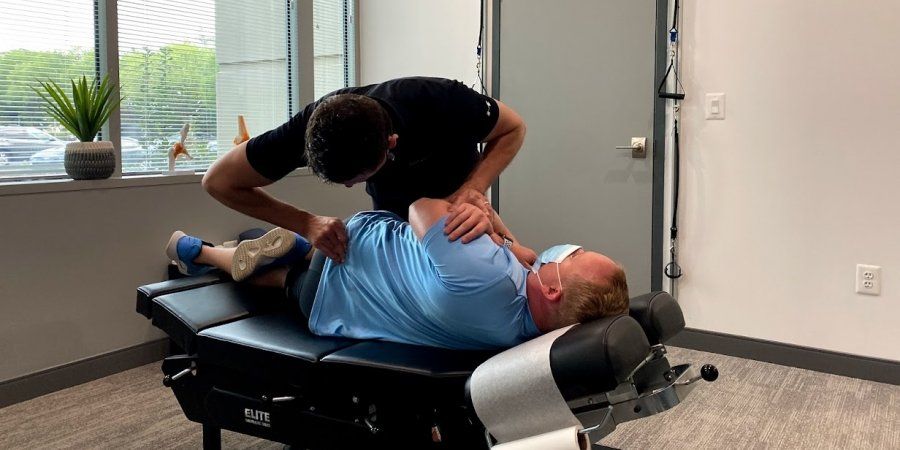The Surprising Truth About Chiropractic Education: Olathe Chiropractic Breaks It Down
7010652882 • August 26, 2023
The Surprising Truth About Chiropractic Education: Olathe Chiropractic™ Breaks It Down

Photo Credit: National Center for Complementary and Integrative Health
When it comes to understanding the amount of training and education that healthcare professionals undergo, most people tend to assume medical doctors sit undisputedly at the top. However, you might be surprised to learn about the depth and breadth of training that doctors of chiropractic receive. In fact, chiropractors receive more hours of education on average than medical doctors. Olathe Chiropractic™ is here to set the record straight.
Comparing Educational Hours: Chiropractors vs. Medical Doctors
Chiropractic Education:
- Undergraduate Education:
Just like prospective medical doctors, aspiring chiropractors first complete a bachelor's degree with a heavy emphasis on the sciences - biology, chemistry, physics, and psychology.
- Chiropractic College:
The real grind begins in chiropractic college. Here, students spend four to five academic years mastering courses in anatomy, physiology, biochemistry, neurology, and specific chiropractic techniques. This amounts to 4,200 to 4,800 hours of classroom, laboratory, and clinical internship, with the average at about 4,485 hours.
Medical Education:
- Undergraduate Education:
Medical doctors, too, start with a bachelor’s degree with a pre-med focus or a focus in the sciences.
- Medical School:
The next step is medical school, which is a rigorous four-year program. On average, MDs receive about 4,000 hours of education in topics like pathology, anatomy, physiology, and clinical rotations.
While the specific distribution of hours varies (e.g., medical students might spend more time in clinical rotations, while chiropractic students delve deeper into musculoskeletal diagnosis), the total hours are comparable, and chiropractors even edge out with a bit more.
Debunking Common Myths About Chiropractors
Myth 1: Chiropractors are not real doctors.
Truth: Chiropractors are licensed as health care providers in all 50 states and many countries around the world. While they do not prescribe drugs or perform surgery, they are thoroughly trained to diagnose conditions and refer patients to other specialists when necessary.
Myth 2: Chiropractic care isn’t backed by research.
Truth: Chiropractic care has been widely studied, especially for conditions like back pain. Multiple studies have demonstrated the effectiveness and safety of chiropractic adjustments.
Myth 3: Chiropractic care is only about “cracking” your back.
Truth: Spinal adjustments or “manipulations” are central to chiropractic care. Still, chiropractors also utilize a variety of techniques, from nutritional guidance to exercises and rehabilitation, to ensure holistic health.
Safety: Chiropractors vs. Medical Doctors
Now, onto one of the most debated topics: safety. Let’s delve into data to understand the risks associated with chiropractic care compared to traditional medical care.
Malpractice Claims:
One way to gauge the safety of healthcare practices is by looking at malpractice insurance premiums. Generally, the riskier the profession, the higher the premiums. Chiropractors’ malpractice premiums are a fraction of what medical doctors pay. This stark difference suggests that chiropractors face far fewer malpractice claims, indicating a lower incidence of treatment errors or patient injuries.
Risk of Death:
It’s crucial to understand that every medical procedure, no matter how minor, carries some risk. Yet, the risk associated with chiropractic adjustments is minimal. Deaths from chiropractic treatments are extremely rare. On the contrary, some medical treatments and interventions, especially surgeries, come with higher risks. For instance, according to studies, the risk of death from gastrointestinal bleeding caused by taking nonsteroidal anti-inflammatory drugs is higher than the risk of death from chiropractic care.
To be clear, this isn’t a contest. Both chiropractors and medical doctors play essential roles in the healthcare spectrum, each offering unique expertise.
In Conclusion: Olathe Chiropractic™ Wants You Informed
At Olathe Chiropractic™, we believe that informed patients make the best healthcare decisions. Knowing the rigorous education and training chiropractors undergo, the myths surrounding the profession, and the safety data can guide you in making the best choice for your healthcare needs.
It's essential to recognize the value of both chiropractors and medical doctors. The goal is to provide patients with the best possible care, irrespective of the title held by the healthcare professional. Now that you’re armed with knowledge, make the choice that feels right for your health journey.

Numerous research studies support chiropractic care as an effective, reliable, and safe alternative to mainstream medicine-based treatment and surgical techniques. Although millions of people in the U.S undergo chiropractic care to improve their physical and mental health, many people have misconceptions about it. You can dispel myths by sharing evidence-based and correct information about chiropractic care with your family members, friends, and colleagues. Today’s article will discuss the myths and truths about chiropractor care to ensure that this revolutionary treatment option can dramatically enhance your health. Read on! Myth 1: Chiropractic Care is only Reliable for Spinal Issues Many people think that chiropractic care is good for spinal conditions. Although this is true, Doctors of Chiropractic care are neuromusculoskeletal systems specialists, meaning they can treat disorders related to muscles, bones, joints, nerves, and soft tissues. In addition to spinal issues, chiropractors can treat: Headaches Neck stiffness Neck pain Numbness Tingling Elbow tendonitis Shoulder tendonitis Ankle sprain Carpal tunnel syndrome Knee and hip pain Plantar fasciitis Asthma Digestive issues Stress, depression, and anxiety And much more Qualified and experienced chiropractors care for the whole person, create winning wellness programs, and combine checkups with nutritional counseling, exercise plans, stress reduction strategies, and other lifestyle modifications. Myth 2: Chiropractic Treatment Causes Pain People who haven’t undergone chiropractic treatment are more apprehensive about manipulations and adjustments. The fear comes from a “cracking” sound during the adjustment procedure. Remember, this sound has nothing to do with discomfort or pain when receiving the treatment. The sound, known as cavitation, is a drop in pressure within your bones or joints, making the stuck or stiff joints unstuck and improving their overall function. So, the cavitation that cracks the bones or rubs against each other is a myth. A professional chiropractor with years of experience performs gentle adjustments and tailors the manipulations and maneuvers according to your body type and requirements. So, there is no discomfort and pain. In fact, you will find it relaxing. Myth 3: Chiropractic Care is Not Safe A growing body of research evidence, including peer-reviewed studies, shows that chiropractic care is a practical, reliable, and safe treatment option for people of all ages, including children and older adults. On the other hand, allopathic medicines/drugs can cause many side effects. Likewise, open and minimally invasive surgeries also lead to complications, such as blood loss, risk of death due to intense anesthesia, pain, muscle damage, nerve issues, and prolonged rehabilitation periods. According to CDC, more than 76,000 people in the U.S end up in a hospital room due to side effects caused by NSAIDs. Although NSAIDs are over-the-counter drugs, they can cause severe complications. The CDC highlights that 7,600 people, on average, die due to NSAIDs. In contrast, chiropractors believe that the nervous system manages and controls all functions in the body. So, chiropractors focus on adjusting the neuromusculoskeletal system to ensure your nervous system, including the brain and spinal cord, work optimally. That way, you proactively mitigate the risk of physical and mental health conditions. The best thing about chiropractic care is that it is 100% safe and free from side effects. Myth 4: Chiropractors are Less Educated Students complete the pre-medical college curriculum before applying to chiropractic school/college/university. The curriculum includes different courses, including biology, chemistry, physics, psychology, neurology, and liberal arts. These are prerequisite courses that require the student of chiropractic care to take at least two to four years to complete. In addition, chiropractic care colleges consist of a full-time or four-year study program with courses like anatomy, pathology, physiology, biochemistry, microbiology, and public health. So, saying that chiropractors are less educated is a myth. Myth 5: Chiropractic Care is the Same as Massage Therapy Although massage therapy is a drug-free technique to relieve stiffed muscles, reduce stress levels, and increase blood circulation, it is different from chiropractic treatment. The reason is that massage therapy does not treat or correct spinal subluxations. Likewise, massage therapists are not doctors. On the other hand, chiropractors have extensive knowledge and training in the neuromusculoskeletal system, nervous system, digestive system, and other organ systems. Chiropractors can even diagnose medical conditions and follow the protocol to perform spinal adjustments and treat the underlying disorder. Therefore, chiropractic care is different from massage therapy. Final Words Chiropractic care is an evidence-based, reliable, efficient, safe, and complication-free treatment option that relieves pressure on bones, muscles, and joints, reduces inflammation/swelling, and improves nerve function. It can treat neck, shoulder, back, and headache pain. However, it is crucial to find a licensed chiropractor with years of experience and a good track record to achieve your holistic health goals. Contact us today!

The backbone or spine is the central musculoskeletal structure in your body, connecting various body parts. It helps your stand, sit, walk, bend, and twist while maintaining the range of motion. However, your lifestyle and activities can affect your spine negatively or positively. For instance, if you fail to exercise and maintain a balanced diet, your spine will experience injuries, conditions, inflammation, pain, and other complications. Your feet play a critical role in supporting your entire body’s weight. Your feet also act as shock absorbers, primarily when walking or running. In addition, your feet maintain the alignment of your spine. So, when you choose shoes or footwear that don’t support or put pressure on your feet, you will experience misalignment in your spine. As a result, your spinal vertebrae will have inflammation, injuries, and other problems. According to our professional and board-certified chiropractor, subluxations, also known as misalignments, are a common cause of neck and back pain. Subluxations can also cause stiffness, spasms, muscle tension, and reduced range of motion in your spine Therefore, it is crucial to undergo chiropractic treatment, such as hands-on spinal manipulation, to improve vertebral alignment, reduce the risk of subluxations, and improve your overall health. Let us discuss the effects of footwear on your spine! High Heels Effect on Your Spine Wearing high heels is fashionable, but it can cause severe effects on your spine. A growing body of research evidence highlights that high heels can put pressure on the feet’s front part. Research shows that when a person wears high heel footwear of one inch, it increases the pressure by 22%. Likewise, a three-inch heel can increase pressure on the front of your foot by 76%. Bear in mind that high heels can also alter your posture due to the unnatural feet position. So this causes your lumbar spine to move forward and disturb its natural curve. Discs are cushions between spinal vertebrae, keeping them firm and flexible. Discs absorb shock and avoid pressure on your spine’s musculoskeletal structures, including bones, joints, ligaments, etc. However, when you wear high heels regularly, you will experience complications in the discs, causing wear and tear and reducing the discs’ ability to absorb shocks. Flip Flop Effects on Your Spine Flip flops are popular footwear among men and women. Although high-end flip flops are reliable, they can still cause complications in your spine, particularly the thoracic and lumbar spine, when worn regularly. Research studies highlight that flip-flops can severely affect a person’s gait, preventing them from walking normally. Changes in gait cause misalignment in your spine, lead to balance issues and contribute to spinal, hip, and knee pain. If you want to reduce the risk of spinal complications, you must choose footwear carefully. At the same time, you must undergo regular chiropractic sessions to improve your spinal alignment. So, even if you wear flip flops frequently, chiropractic manipulation will reduce the risk of spinal problems. Choosing the Right Footwear Our chiropractor, with years of experience treating spinal pain, disc problems, and musculoskeletal issues, recommends that people choose the proper footwear that supports their spine. Here are a few tips from our professional chiropractor. Choose Footwear with Lower Heels We have already discussed how high heels can affect your spine. So, we recommend choosing or buying footwear with lower heels. Remember, the lower the heels, the better. The purpose is to lower the pressure on your feet and prevent spinal misalignments. Avoid Flip Flops Many men and women have an obsession with flip flops. Although flip flops are an excellent choice fashion-wise, they harm your spine and overall wellbeing. Therefore, we recommend avoiding flips flops and choosing comfortable footwear to reduce pressure on your muscles. Choose Shoes with Cushions When you wear shoes with cushions, you will experience less fatigue, pressure, and pain in your feet, legs, and spine. Well-cushioned footwear can absorb shocks and keep your feet comfortable. When your feet feel comfortable, your spine will stay healthy and well-aligned with an improved range of motion and flexibility. Final Words A comfortable and well-cushioned pair of shoes or footwear improves your feet’s position, stability, and comfort levels, leading to enhanced posture and gait. Proper posture corrects spinal alignment and allows muscles in your spine to work efficiently. At the same time, a good pair of shoes prevent strain on your spinal vertebrae and discs. Make sure you undergo chiropractic treatment if you want to create balance between your lifestyle, fashion, and spinal health. Our chiropractor has years of experience using different techniques to improve spinal alignment, range of motion, and overall health to prevent back spasms, stiffness, and pain . Contact us today for more information.

Chiropractic care is a non-invasive and patient-centered approach that uses various techniques to treat musculoskeletal disorders. A qualified and board-certified chiropractor focuses on the patient’s spine, muscles, and nervous system. A growing body of research evidence shows the effectiveness of chiropractic care for various health conditions. The best thing about chiropractic care is that people resolve their health issues without taking medicines or undergoing surgery. Chiropractic care is directly proportional to improved quality of life and overall physical and mental wellbeing. However, it is crucial to find an experienced and skilled chiropractor to achieve your health goals. A qualified chiropractor follows a step-by-step approach to evaluate your health condition and uses their clinical expertise and evidence-based techniques to diagnose and treat your condition. Chiropractors use different methods, such as: Spinal manipulation Spinal adjustment Soft tissue therapy Cold laser therapy Therapeutic ultrasound Customized exercises However, the most common techniques used by a chiropractor to treat musculoskeletal problems are adjustment and manipulation. Many people think these methods are the same. However, evidence shows that they are different. Today’s article will differentiate between these two techniques. Read on! Spinal Adjustment Chiropractic or spinal adjustment is a sophisticated technique used by chiropractors and trained specialists. It involves using hands or small instruments to apply a sudden and control force to spinal muscles and joints. The primary goal of this procedure is to improve spinal motion and enhance the patient’s overall body functions. The technique is beneficial for various conditions, including cervical pain, thoracic pain, lumbar spine pain, sciatic pain, and neck pain. In addition, when you visit a chiropractic clinic, the health professional will ask questions about your medical history and perform different exams, including a physical examination, to diagnose the issue. Some diagnostic procedures performed by the chiropractor are x-rays, blood tests, etc. Procedure The chiropractor will place you in a specific position to treat your spinal problem during the session. The most common position is lying face down on the table with padded cushions. Besides, the chiropractor will use their hands to apply pressure on your spinal joints to improve the strength, flexibility, and range of motion. While applying the force to your spinal joints, you will hear popping and cracking sounds. The reason is that your chiropractor moves your joints. Although the spinal adjustment is a safe procedure, some patients may experience minor side effects after the session. These include dizziness, fatigue, headaches, and pain in the treated areas. Benefits Unlike medications and surgeries, the spinal adjustment is a reliable and safe technique that reduces the risk of complications. For instance, adjustment can treat spinal conditions and relieve related symptoms, such as migraines, neck pain, spinal injuries, pain in the leg due to sciatica, and whiplash. A chiropractic adjustment is one of the most reliable techniques in treating lower back pain. About 80% of Americans experience lumbar spine pain at some point in their lives. Many research studies show that adjustments can treat neck pain and neurological disorders. Spinal Manipulation Spinal manipulative therapy, also known as spinal manipulation, is a highly reliable chiropractic technique that combines various methods, such as exercise, physical therapy, and massage. The primary purpose of spinal manipulation is to reduce inflammation, relieve joint pressure, and enhance nerve function. In addition, manipulation is an effective technique for treating discomfort, inflammation, and pain in different body areas, including the back, neck, arms, and shoulders. Chiropractors also use manipulative therapy to treat sinus problems and menstrual pain. Procedure Research shows that chiropractors use over one hundred spinal manipulation techniques based on the patients’ specific requirements and health conditions. The most common procedures are spinal manipulation and mobilization. The former uses force, pressure, and twists, and the latter involves more gentle pressure applied to the joints. Spinal manipulation techniques include ice and heat therapy, electric stimulation, and traction devices that allow the chiropractor to stretch the patient’s spine. Ultrasound is another procedure performed for deep tissue heating. The chiropractor uses a padded table to carry out these techniques. During spinal manipulation, a qualified health professional uses their hands to apply a sudden force to specific joints in your spine. Benefits Spinal manipulation offers a wide range of benefits, such as relieving back pain, chronic migraines, severe headaches, chronic joint pain, sciatica, neck pain, and shoulder pain. Another advantage of chiropractic manipulation is avoiding surgery because the technique follows a non-invasive approach. Because surgery can lead to various complications, such as infections, muscle problems, disc damage, and prolonged rehabilitation, you can avoid these problems by undergoing regular spinal manipulation to achieve your goals. In addition, you can avoid medications to manage your discomfort, inflammation, and pain in your spinal joints. Reduced drug dependence can improve your quality of life by mitigating the risk of side effects. Moreover, spinal manipulation improves the range of motion in your back. It also increases flexibility and strengthens your spinal muscles and skeletal structures, allowing you to live a happier and more comfortable life. Final Words Spinal adjustment and manipulation are the most common chiropractic treatments for back pain and related conditions. Your chiropractor will decide which treatment method best suits your needs. Contact us today for more information.

Chiropractic care is a sophisticated procedure that involves using hands or small instruments to apply a controlled force to joints, particularly spinal areas, in your body. The primary goal of chiropractic care or treatment is to improve spinal motion and enhance the body’s ability to perform physical functions appropriately. Most people think that chiropractic care is a treatment option for adults. However, this is a misconception. A growing body of research evidence shows that babies, children, and adolescents, can also seek this treatment. Data shows that chiropractic care is one of the most popular treatment options for kids in the U.S. According to the Centers for Disease Control and Prevention (CDC), more than 3% of children in the U.S visit chiropractic at least one to two times. Multiple research studies have examined and validated the safety of chiropractic care for kids. Because chiropractic care is safe for children, today’s article will highlight its benefits. Read on! Promotes Sleep Most parents find it challenging to get their children to bed at night. Although sleep-related issues are not common in children, those suffering from sleep problems may suffer from various health conditions, including psychological disorders. Therefore, sleep training for children is essential to promote a good night’s sleep and prevent mental health conditions. However, sleep training does not work for all babies and children. For example, if your baby or child has a misalignment in the spinal vertebra, it can cause severe discomfort and pain. It may also disrupt the nervous system’s functions, preventing your child from sleeping correctly. A qualified chiropractor uses spinal manipulation techniques to fix the misaligned vertebra and restore its function. Therefore, chiropractic care is an excellent solution for promoting a good night’s sleep and reducing the risk of health conditions associated with spinal misalignment in children. Relieves Colic A growing body of research evidence has proven the efficacy of chiropractic care for children when mitigating the risk of various childhood health problems. One of these conditions is colic in babies. A professional chiropractor with years of experience knows how to treat chronic cases of colic in babies. The purpose is to reduce the incidents of colicky crying and ensure your baby stays calm and relaxed. In addition, chiropractic care is an excellent treatment option for sinus congestion and earaches in children. The chiropractic uses different adjustment techniques to drain the fluid from the ear to relieve the symptoms of ear problems, including discomfort and aches. In addition, chiropractic care is beneficial for asthmatic children because it helps reduce misaligned or pinched nerves to streamline the function of bronchial tubes, diaphragm, and lungs. Therefore, taking your child to a qualified and experienced chiropractor can improve their lungs’ health. Reduces Injury Risks Children have more flexible bones than adults. However, children’s bones are prone to injuries due to falls and accidents. Regular chiropractic care can prevent the risk of injuries in children by keeping the muscles, bones, joints, and ligaments supple. In addition, when your child begins to sit up, turn over, crawl, pull up, and walk, the risk of injuries increases. Therefore, it is crucial to undergo regular chiropractic sessions to strengthen the bones, joints, and muscles. That way, your child can have a more effortless and smoother transition with fewer risks of accidents and injuries. Moreover, bumps and bruises are common for children. Sometimes, an accident causes microtrauma due to tripping or falling. Remember, trauma can take a toll on your kid’s psychological health and lead to subluxations, increasing the risk of chronic health conditions. An expert chiropractor with extensive knowledge and years of experience can treat misalignments and subluxations in children. Helps with ADHD ADHD is a common neurodevelopmental condition in childhood, causing various problems, such as difficulty paying attention and controlling impulsive behaviors. Dealing with ADHD is challenging for both children and parents, hindering their ability to live a happier life. Multiple research studies have shown that chiropractic care is beneficial for children with ADHD. Many children improve their ADHD symptoms with regular chiropractic sessions. Although more research is needed, chiropractic care is safe because it does not cause side effects, unlike medications. Final Words Chiropractic care is 100% safe and effective for childhood disorders. However, you need professional, qualified, and experienced chiropractor’s services to ensure everything goes well without any adverse effects. Contact us today for more information.

Sciatica is a health condition that describes various symptoms in your lumbar spine, hips, and legs. The condition is characterized by dysfunction in the sciatic nerve, causing severe discomfort and pain that radiates through the buttocks down your legs. Sciatica can decrease sensation in the lower extremity and cause weakness in the leg. Irritation or compression of spinal nerve roots can cause a set of symptoms, including discomfort, inflammation, pain, leading to disability. The condition commonly affects people between 30 and 50. Although you can take medications, undergo physical therapy and surgery (open-back and minimally invasive surgery), these treatments can cause long-term side effects. On the other hand, chiropractic treatment is non-invasive, free from side effects, and safe to relieve sciatic pain, allowing you to return to your day-to- day life efficiently and quickly. A qualified chiropractor with years of experience can diagnose the underlying cause of pain and prescribe appropriate treatment options to restore your health. Causes of Sciatic Pain There are two categories of sciatic pain causes: the common and rare ones. Common causes of sciatic include herniation in the lumbar spine disc, a condition characterized by irritation or compression in the spinal nerve root by a damaged intervertebral disc. Other spinal disorders, such as spinal stenosis, degenerative disc disease, sacroiliac joint dysfunction, piriformis syndrome, and spondylolisthesis, can also cause sciatic pain. Spondylolisthesis is due to the sliding of one vertebra over the adjacent one caused by physical stress, trauma, or congenital factors. On the other hand, rare causes of sciatic involve spinal tumors, cauda equina syndrome, and lumbar spine infections. Cauda Equina syndrome is due to trauma, compression, or damage to different nerves located at the base of the spinal cord. Chiropractic Care for Sciatica Pain Unlike other treatment options, chiropractic care is a holistic health approach that treats a wide range of musculoskeletal and neurological disorders, including sciatic nerve pain or dysfunction. A professional chiropractor can diagnose the underlying cause, such as sacroiliac joint dysfunction, disc herniation, or piriformis syndrome, and initiate the treatment process to relieve discomfort and pain. Besides, your chiropractor can guide and counsel you on an appropriate course of action to effectively and safely resolve sciatica. For example, joint manipulation is an evidence-based and practical approach to treat sciatica, relieving acute back pain caused by a protruding intervertebral disc. In addition, when you undergo chiropractic treatment for chronic lumbar spine pain and sciatic nerve pain, you can benefit from self-efficacy motivation, enhancing your coping abilities to mitigate the risk of disability. Spinal Adjustments Your chiropractor will apply spinal manipulation to restore the original position of a herniated disc. During the process, your health provider will use specialized manipulation methods to take the pressure off your sciatic nerve. A growing body of research evidence shows that spinal adjustments or manipulations can free limited movements and realign intervertebral discs. Massage Therapy Massage therapy is another effective treatment option to relieve sciatic pain. However, not all chiropractors can carry out the task efficiently. On the other hand, our chiropractor has years of experience in massage therapies and chooses the right approach based on your health status, signs, and symptoms. During massage therapy, our chiropractor uses different relaxation techniques to stimulate muscles, allowing them to release endorphins. These chemicals are natural painkillers that relieve discomfort, inflammation, and pain. While spa massage can release tension and soreness in your spinal muscles, chiropractic massages performed by our professional health provider are directly proportional to healing sciatica and soothing the surrounding nerves. All this translates to relieving pain. Ultrasound Depending on your symptoms and cause of the sciatic nerve pain, our chiropractor may prescribe you to undergo ultrasound therapy. It is an effective chiropractic treatment option that applies gentle heat to your spine. The sound waves penetrate deep into your spinal tissues and improve blood circulation to the injured area. The purpose is to promote healing and reduce swelling, spasms, cramping, inflammation, and pain. Final Words Chiropractic care is a non-invasive, drug-free, and safe treatment option for neurological and musculoskeletal disorders, including lumbar spine and sciatic nerve pain. The primary goal of chiropractic treatment for sciatica is to restore spinal movement, improve spinal function, relieve pain, and fix the damaged nerves. Depending on sciatica causes, the treatment plan covers various methods and techniques, including ice/heat therapy, spinal manipulation/adjustments, TENS therapy, ultrasound, and rehabilitative sessions. Contact us today!

About 80% of people in the U.S experience back pain at some point in their lives. Improper movement, lifting heavy objects, inaccurate sleep position, injury resulting from an accident, and spinal disorders, such as degenerative disc disease or herniated disc, can lead to discomfort and pain in the cervical, thoracic, or lumbar spine. However, disc herniation usually occurs in the lower back, causing significant pain that can radiate through the buttocks in the legs and cause sciatica. There are numerous causes and risk factors associated with disc herniation in the spine. Although medication, physical therapy, and surgery can reduce painful sensations, they can cause side effects. On the other hand, chiropractic care for herniated disc is safe and reliable. Read on! What is Disc Herniation? A herniated disc is a spinal condition characterized by severe pain and numbness in the back. The problem occurs when there is a rupture in the outer part of the disc, causing the inner jelly-like material to leak out and compress the surrounding nerve root. The nerve root compression leads to tingling, numbness, burning, shooting sensations of pins and needles. Sometimes, the pain runs down the arm or leg. Disc herniation can cause weakness in the muscles of your arm and leg. It can also lead to loss of bladder and bowel control. How Does Chiropractic Care Work for Herniated Disc? A qualified chiropractor with years of experience can address painful symptoms of a herniated disc. A professional chiropractor follows a step-by-step approach to review your medical history, perform physical exams, and conduct neurological tests. The purpose is to determine whether your reflexes are intact and nerves send messages correctly. Likewise, diagnostic tests help the chiropractor determine muscle strength loss. These tests also determine the loss of sensation along the nerve path. Besides, our chiropractor will examine your posture and perform an X-ray or MRI for a clear view. Our chiropractor makes substantial efforts to develop a solid treatment plan that includes spinal manipulations, adjustments, and other techniques to relieve pain caused by the herniated disc. Flexion-Distraction Flexion-distraction is commonly used for spinal disorders, including a herniated disc. The patient lies on a specialized table during the procedure, and the chiropractor performs gentle distracts on the spine. The purpose is to isolate the spine's damaged area and flex the muscles and other structures using a pumping rhythm. As a result, the nucleus pulposus gets in the proper position at the center of the intervertebral disc. In addition, the technique is also effective for improving the height of the intervertebral disc. That way, the disc moves away from the nerve, leading to reduced compression or inflammation. All this translates to reduced discomfort, tingling, numbness, and pain. Pelvic Blocking Techniques Pelvic blocking is another technique used by chiropractors to relieve painful symptoms of a herniated disc. During the procedure, the chiropractor places cushioned wedges under the pelvis to change the mechanics and move away from the disc from the nerve root. As a result, there is less compression and inflammation in the affected area. A few sessions of pelvic blocking techniques can help you fully recover from the herniated disc without any side effects, making chiropractic care safer and reliable. Final Words Chiropractic care is a sophisticated and holistic approach to restoring your body's normal functions. Manipulations and adjustments on the spine can treat various conditions, such as degenerative disc disease and herniated disc. Not only does chiropractic manipulation reduce inflammation in the affected area, but it also increases mobility and range of motion. At the same time, it strengthens your spine's muscles and makes them flexible. Contact us today if you experience symptoms of a herniated disc. Contact us today!




